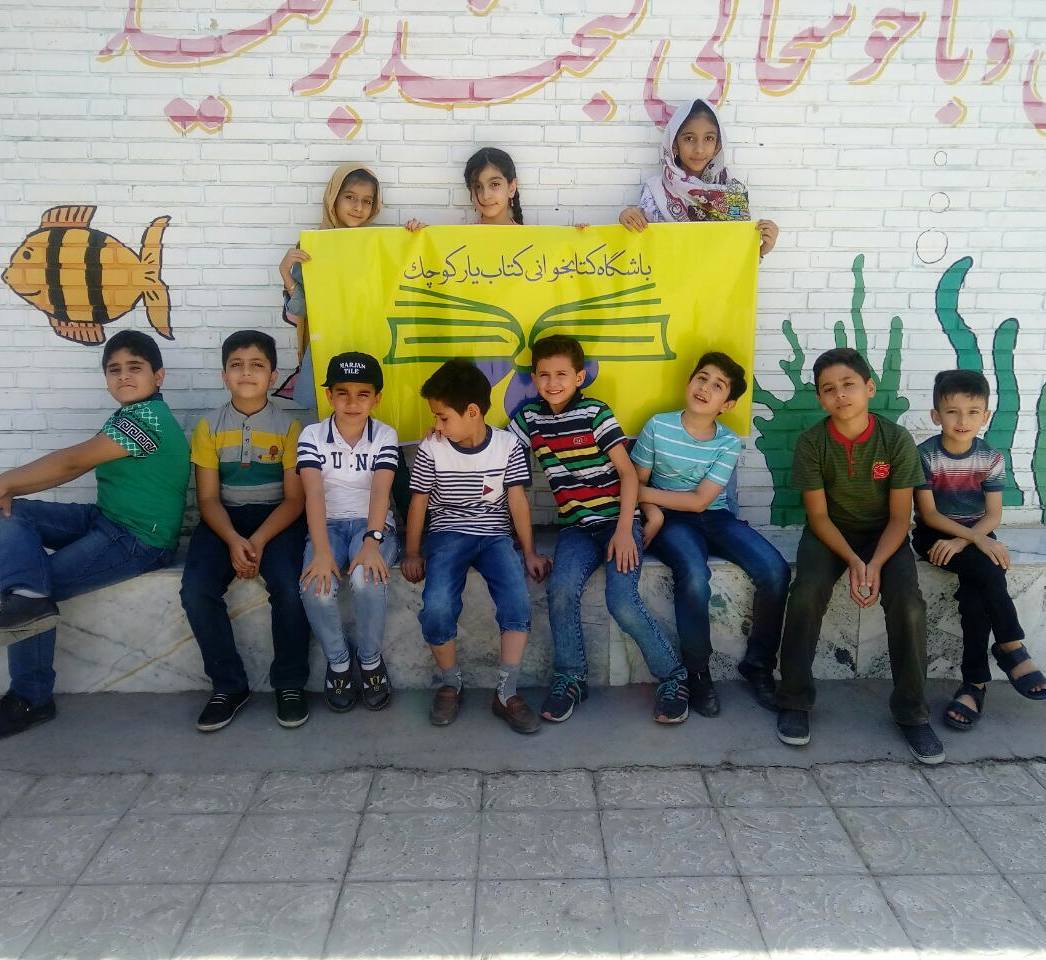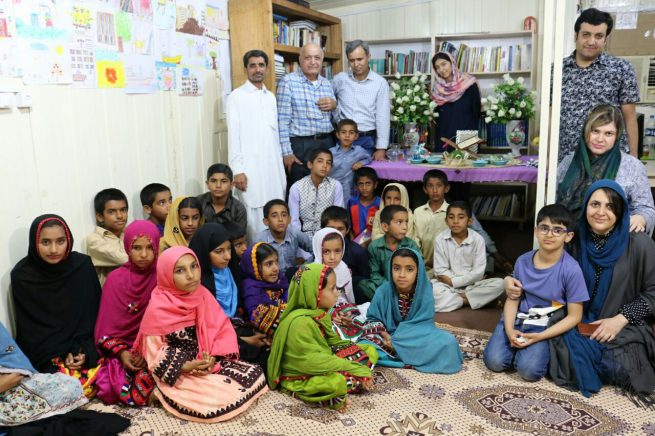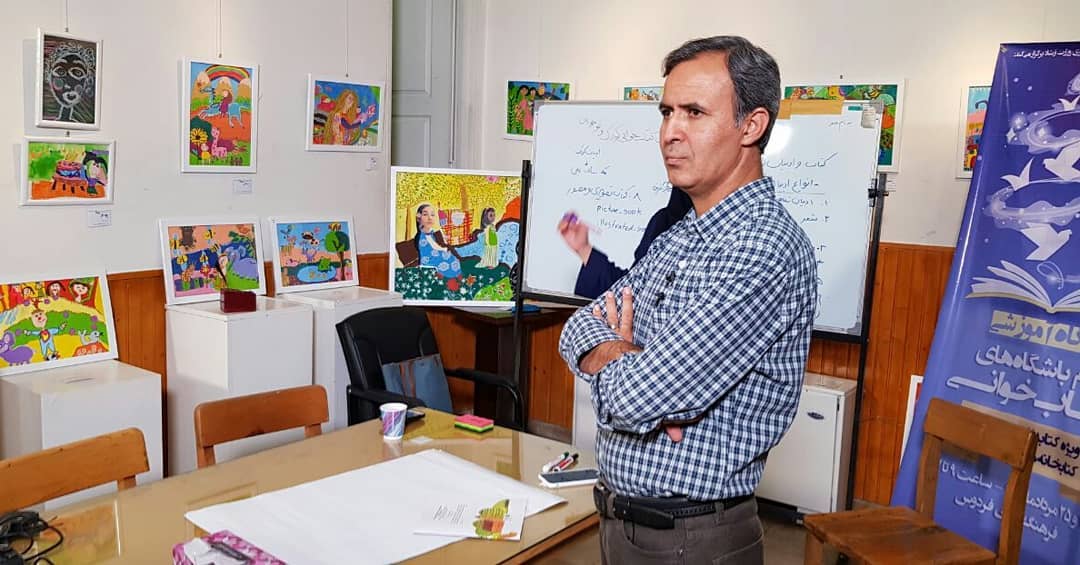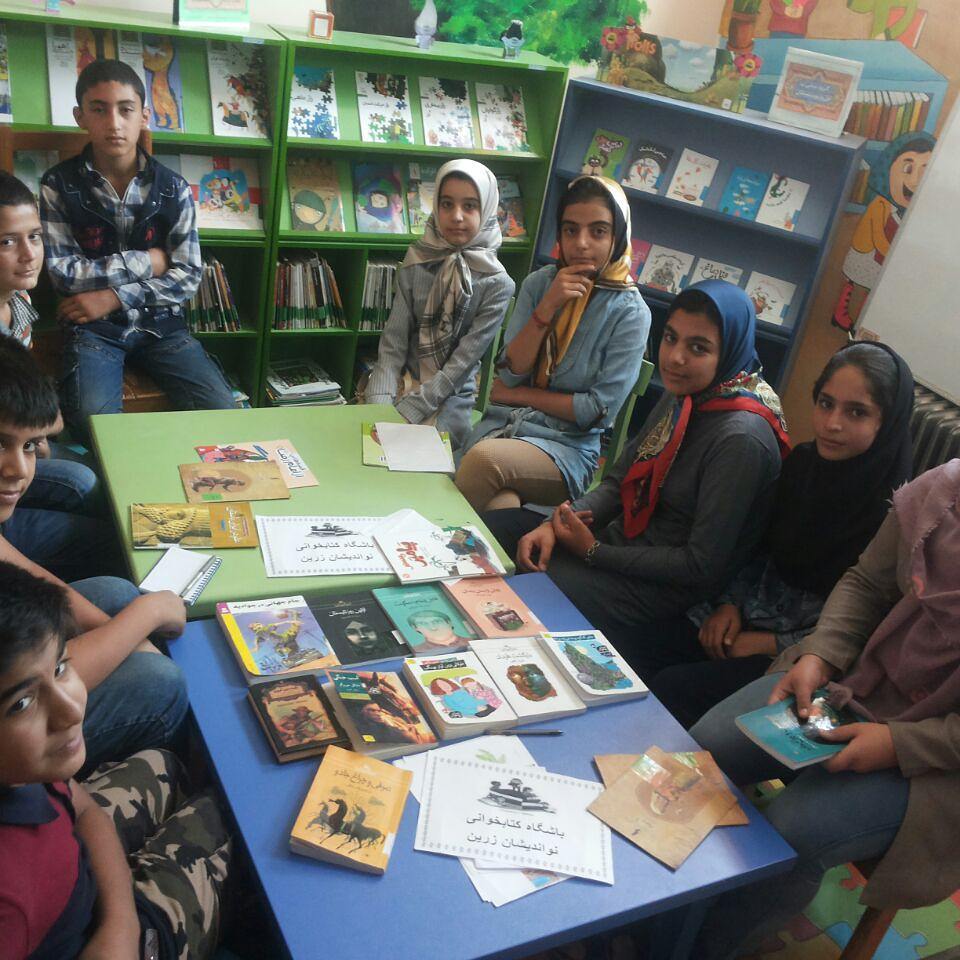The idea of a series of competitions in the format of football cup around books and reading by children was presented by Ali Asghar Seidabadi to a school. Now, after several years of practice and development, the Cup of Reading Clubs for Children and Young Adults is national event that is annually held in all over the country. Every year, a group of writers for children travel to different cities and organize workshops for local teachers, librarians, Kindergarten coaches, parents, book promoters and everybody who is interested. The workshop is about how to read for children and how to organize a small community of children for group reading. The “facilitators” who are trained in these workshops start gathering and listing around 12 children and young adults within the same age group for their reading clubs. When the clubs are registered in bookpromotion.ir, the members can buy a number of books at 50% discount in their local bookshop. Every member buys at least one book, reads it, brings it to the club and talks about it. Then the members exchange book and through the 8 to 12 weeks of activity everybody in club has read a number of books. They argue for and select the most favorable book they have read, write a letter to their favorite author and make a one minute film about it.
In addition to these minimum activities, the club performs any other creative activity it feels good and necessary. Finally they must submit a report on their activities for the secretariat, the profile is required to be well-documented and it should include the name of the selected book, collection of letters to writers, and the collection of short video clips on books they have read. The best arguments and most creative plans, performances and activities are the subject of competition at local, regional and national levels. In the final ceremony, both the winner clubs and the highly graded authors and illustrators are appreciated.
Most of the clubs that are formed in this process continue to gather and read even beyond the final round of competitions.

Partners
Reading Clubs for Children and Young Adults is an event supported by a variety of different civil and non-governmental organizations including Association of Writers for Children and Young Adults, Network of Book Promotion Groups, HAMI Association, Children Cultural Development Center, some international partners including UNISEF, public institutes such as municipalities, city councils, village councils, Iranian House of Books, and governmental bodies such as Ministry of Culture, Institute for the Intellectual Development of Children and Young Adults, Ministry of Education, etc.
History
Running a reading club is not a new idea and there are a variety of well-reported reading clubs all over the world. A reading club for children with plans to competition at national level, however, is a new and fanciful; at least the sheer participation of so many children proves this.
It was Mr. Ali Asghar Seidabadi who first presented the idea to a school in Neishabur, asking them to read and exchange books in small groups and form a library in their classrooms.
An expanded version of the idea to run in a city found its way among the programs of Neishabur for her nomination as national book capital. Later on, Seidabadi and his colleagues worked on it for implementation at national level.
The educational system of Iran is an old system with heavy homework and little room for children’s freedom and creativity and does not allow any other organization to participate in the process. Therefore reading clubs for students was transformed into an independent reading clubs for children to make it free from the boundaries of schools and to invite a variety of different stakeholders into the process.
To make the idea more familiar, it was designed after popular football club competitions. Cup has certain associations and connotations in both Christian western world and ancient Persian world.
Initially, given the special structure of Iranian society and government, the idea was evaluated as too ambitious and unconventional for implementation, therefore only 15 candidate cities where selected as pilot. These 15 cities were high profile cities during the previous round of national book capital designation with active governmental and non-governmental bodies being present in the city.
Afterward, a group of civil and non-governmental organizations such a the Association of Writers for Children and Young Adults, Council for Children’s Book and active book promotion groups were invited for collaboration. They introduced a number of prominent writers, scholars, activists and experts. The resulting group of people decided on a two day workshop to discuss and decide on a concerted and coherent and approach to book and its promotion across the country. The workshop also resulted in the main plan for further workshops in every city.
These were the workshop where Mr. Ali Asghar Seidabadi talked about his experiences of book promotion in different rural and urban settings.
In 2014 the writers and book promotion activists who have attended the workshops travelled to different cities to run workshops. The ‘facilitators’ who participated in these workshops were mostly local teachers, librarians, NGO activists and a variety of other people with access to a number of children in diffenet setting, even in residential buildings. After participation in a two day workshop, they were certified to build and run a reading club for children or young adults.
The number of cities and villages to run reading clubs increased to 102 in the second year. In the third year, more than 1700 cities and villages have volunteered for running reading clubs.

Stages of Running Reading Clubs for Children and Young-Adults
- Formation of executive committees in cities and provinces
- Running workshops for local facilitators
- Formation of clubs and registering them
- Members buying books with 50% discount
- Exchanging and reading all the books by the members
- Discussing books
- Selecting the best books by the members
- Writing a letter to favorite authors
- Making a short video on the subject of books
- Doing creative group works
- Documenting the activities of club
- Assessment and evaluation of club profiles at local level
- Running celebrations for clubs at local level
- Submiting the profile of the city and successful clubs to the national secretariat
- Final evaluation
- Celebration of reading clubs and nomination of most successful clubs, short films, letter to authors, and appreciation of the best authors, translator and illustrators as voted by club members

Characteristics
There are certain characteristics that has made the reading clubs attractive to children and young adults:
- It has a simple and familiar structure;
- It provides collective and participatory activities for children.
- It has a minimal and flexible structure, inviting the members to run their own creative plans.
- It provides new spaces for collective and active reading.
- It enables children to read deeply and actively to talk and argue on their special reading of the text.
- Its simple and familiar structure can be reproduced in a variety of social settings.
- It provides great potentials for networking and linking reading promotion activists and the transfer of experiences.
- It demands for a variety of different organizations participation.
- It can be used as a platform for thinking about, discussing, and providing solutions to certain broader social problems.
- Cities and villages are voluntary in their participation and they need to provide some conditions for joining the cup.

Workshops and sharing experiences
In the workshops for facilitators in different cities and villages, the following topics are presented:
- The benefits of reading today’s world
- Approaches to reading promotion
- How to set up reading clubs
- Evaluation of books and literature for children and young adults
- How to talk about a book
- Documentation and dissemination of club activities
In addition to running workshops for sharing experiences, a booklet is published with further discussions on the topics. Also, a series of training films are produced with the presentation of two authors and reading facilitators in each volume.
These booklet and videos are also available in bookstores and local libraries for the assistance of facilitators throughout the country in running their workshops and clubs.

List of selected books
The task of book selection for reading in clubs is given to facilitators and club members and they can find materials in local libraries or bookshops. But for using their share of 50% discount, a special list of book is compiled from the best books available in the market. The list is no less than 1000 titles from best translation and creative works published in recent years and is a combination of several other lists provided by a variety of institutes and organizations.
Impacts
Reading clubs for children and young adults is one the most socially effective initiative in contemporary settings. Beside tangible effects of increasing readings in volunteer cities, reading clubs has significant social impacts:
- Club members, according to their families and teachers, have gained many abilities over the course of activities; they have found higher self-esteem; they have developed the ability to talk and argue, and have even been more successful in their classroom and social activities. This is a direct result of participatory, collective, critical and creative nature of work in reading clubs.
- Many teachers, trainers, volunteers, librarians and independent activists for book promotion find a strong network for further collaboration and sharing of energies and experiences that goes far beyond reading clubs.
- The program has created new spaces for the cooperation, collaboration and resource sharing of various stakeholders including private and public organization for reading promotion.
- Reading clubs has strengthened the spirit of collective work and inclusiveness among children and adolescents.
- The first year more than 2000 members participated, in the second year about 5000 children and young adults registered in clubs and this will certainly find an exponential growth in the third year as more than 1700 cities and villages are volunteering.
- Many club members report on their club activities in their independent social media and social networks. This is beside more official reports on club activities in mainstream media.
- A field research conducted by the Association of Book Distributors shows an increase in book demand in all volunteer cities. Other assessments indicate children reading up to 140 books during club activities.
- Given the economic crisis facing small bookstores in small cities, the program has proved useful in creating more prosperity. The club members are encouraged to visit bookstore and different supporters including the state ministry of culture offer special discounts for books.
- Reading clubs lead to the idea of Reading Mondays in kindergartens and preschool centers where they are required to allocate a day in the week for reading.
- Clubs has proved useful in creation of a link between readers and writers. Children feel they can communicate with their favorite writers.

50 Letters from club members and writer’s answers
The club members are required to write a letter to their favorite writer, translators or illustrators.
When reading the letters, the club assessment team found the letters highly interesting and important and suggested them to be published along with answer by writers.
Thus the letters became the subject an exhibition and then they were submitted to 50 target writers, translators and illustrators for their answer. The selected letters along with the answer they receive will be published by the start of the third year of reading club activities.
Reading club activities
General activities include:
- Buying books
- Exchanging books
- Reading the exchanges books
- Conducting talks, group presentations and dialogues on the subject of books they are reading
- Selection of the best book
- Writing letters to favorite writers, translators, and illustrators
- Making a short movie for creative presentation of the book read in club
Beside these minimum activities, every club is free to perform a series of innovative activities such as:
- Communication with favorite and available writers and book producers through social media
- Inviting writers and book producers to the club
- Recognition and meeting with regional writers and book producers
- Running club rallies on the way to bookstore
- Performing creative presentations of the stories
- Planting in special vases for every writer they are reading and exhibition of these vases in different occasions
- Running ceremonies of reading for the sea on Thursdays and cleaning the beach by club members
- Planting trees for their favorite writers in city parks and other open locations
- Integration of reading activities with indigenous cultural events
- Running clubs for children with disability

Fact and Statistics
- Training of more than 7000 facilitators across the country
- Formation of around 2000 reading clubs with 24000 members in the first year
- Formation of more than 5000 reading clubs with more than 70000 members in the second year
- Volunteering of 1304 cities and 433 villages for running reading clubs in the third year
- UNICEF is a new partner in the third round of running reading club activities.
0 Comments